Meteorcomm 63030-48 Packet Data Transceiver - Fixed Use - 48VDC User Manual ITCR Base Radio User s Guide
Meteorcomm LLC Packet Data Transceiver - Fixed Use - 48VDC ITCR Base Radio User s Guide
Contents
- 1. User Manual 1
- 2. User Manual 2
- 3. Users Manual
User Manual 2
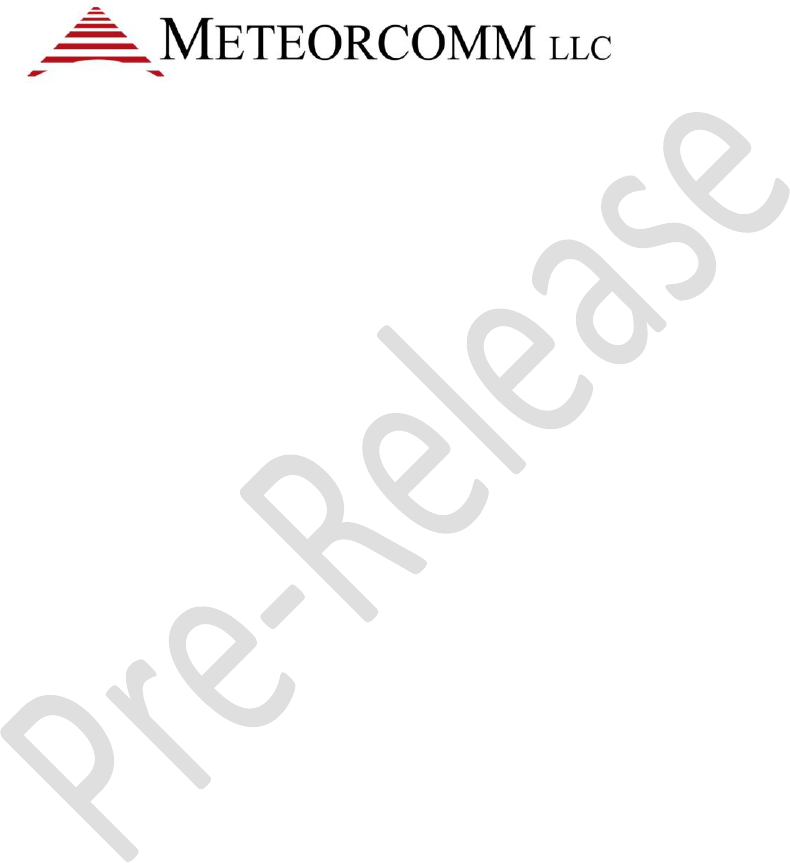
ITCR Base Radio
User's Manual and Installation
Instructions
Applicable Models: 63030-24, 63030-48
Note: The final version of this manual will include a French translation.
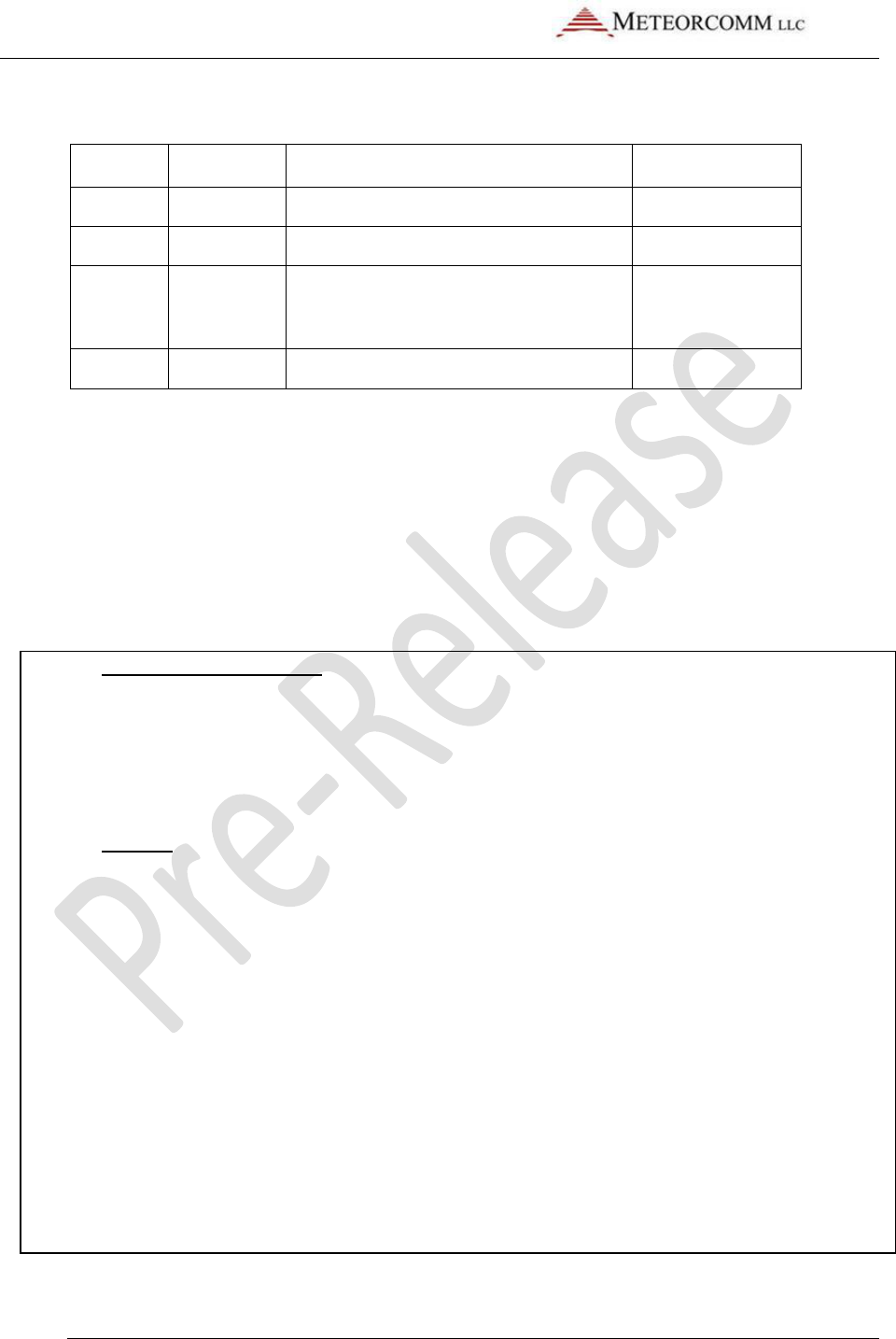
ITCR Base Radio User's Guide
© 2011 Meteorcomm LLC. All Rights Reserved. Proprietary and Confidential
ii Do Not Distribute 9/8/2011
Revision History
Revision
Date
Summary of Changes
Contributor
0.1
Initial draft.
Neil Ross
0.2
Changes by Neil Ross.
0.3
8/29/2011
Add notices to user and expanded
RF exposure Information. General
editing.
Fred Cleveland
0.4
9/8/2011
Fix errors and omissions
Fred Cleveland
Document Number: HWD-PTC-
Date Complete:
Confidential and Proprietary Notice
This document contains information that is considered confidential and/or proprietary to Meteorcomm® LLC (“MCC”) and shall
not be disclosed, transmitted, distributed, duplicated or used in whole or in part except as agreed under separate contract
between MCC and the recipient. All information contained herein shall be kept confidential.
MCC makes no representations or warranties, express or implied. All warranties, including but not limited to, warranties of
merchantability, fitness for a particular purpose, and non-infringement are hereby expressly disclaimed.
Unless expressly authorized in writing, the name and trademarks of MCC may not be used. All other rights are reserved.
Disclaimers
This is a draft document only but provides sufficient information to support an initial engineering project. The estimates
contained herein represent MCC’s current best estimates and will be refined over time.
MCC makes no representations or warranties of any kind, express or implied, about the completeness or accuracy of the values
contained herein. Any reliance placed on these values is done strictly at the risk of the user.
Any designs contained in the document were developed using standard layout guidelines for most common and practical
applications. All schematic symbols, footprints and layer definitions should be validated by the customer’s own technical experts
as application specific requirements may differ.
By downloading, using, or referring to a schematic, design or footprint, the user agrees to release MCC from all liability related to
the use or application of the schematic, design or footprint.
©2011 Meteorcomm LLC. All rights reserved.
Meteorcomm is a registered trademark of Meteorcomm LLC.
Document Number: XXX-XXX-0000XXXX

ITCR Base Radio User's Guide
© 2011 Meteorcomm LLC. All Rights Reserved. Proprietary and Confidential
9/8/2011 Do Not Distribute iii
Table of Contents
1. Overview ............................................................................................................................. 1
1.1 Applicable Radio Models and Identifiers ................................................................ 1
1.2 General Description ................................................................................................ 1
1.3 Chassis ..................................................................................................................... 2
1.4 Ports and Ethernet Connectors .............................................................................. 2
1.5 Power Connectors ................................................................................................... 2
1.6 Antenna Connectors ............................................................................................... 2
2. Important Information for the User ................................................................................... 3
2.1 Transmitter warm-up period. ................................................................................. 3
2.2 RF Safety ................................................................................................................. 3
2.3 Limiting RF Exposure ............................................................................................... 4
2.4 Fixed Antenna Guidelines ....................................................................................... 4
2.5 RF Interference to Residential Receivers ................................................................ 5
2.6 Equipment Modifications ....................................................................................... 6
3. Setup and Configuration for the Base Radio ...................................................................... 6
3.1 Input Power ............................................................................................................. 6
3.2 Ethernet Connection ............................................................................................... 7
3.3 RF Output Termination ........................................................................................... 7
4. Tuning the Base Radio ........................................................................................................ 7
4.1 Equipment Required ............................................................................................... 8
4.2 Set up the Radio for Testing ................................................................................... 8
4.3 Measure and Calibrate Reference Crystal Oscillator Parameters .......................... 9
4.4 Measure and Adjust Output Power ...................................................................... 10
4.5 Check and Adjust RF Output Channel ................................................................... 11
5. Operations ........................................................................................................................ 12
5.1 Restore Factory Settings ....................................................................................... 12
5.2 Display Software and Firmware Revision Numbers ............................................. 12
5.3 Display Radio Identification Information .............................................................. 12

ITCR Base Radio User's Guide
© 2011 Meteorcomm LLC. All Rights Reserved. Proprietary and Confidential
iv Do Not Distribute 9/8/2011
Table of Figures
Table 1. Required Distance Between Personnel and Transmitting Antenna ..................... 4
Table 2. Base Radio Input Power Parameters………………………………………………………………..6

ITCR Base Radio User's Guide
© 2011 Meteorcomm LLC. All Rights Reserved. Proprietary and Confidential
9/8/2011 Do Not Distribute 1
1. Overview
This document provides important radio frequency safety information and
instructions for the basic operation and adjustment of the base station radio. This
document pertains to Meteorcomm Interoperable Train Control Radio Network
(ITCR) Base Radio models, numbers 63030-24 and 63030-48. Operation of these two
models is identical except for input power requirements of 24 Vdc and 48 Vdc,
respectively.
1.1 Applicable Radio Models and Identifiers
This document applies to two Base radio models listed below along with their
regulatory identifiers. These two models differ only in their power supply input
voltage and associated power supply circuits.
Model: 63030-24
FCC ID: BIB63030-24
IC: 1300A-6303024
1.1.1 Model: 63030-48
FCC ID: BIB63030-48
IC: 1300A-6303048
1.2 General Description
Meteorcomm base radios are designed to satisfy the industry standard Positive Train
Control (PTC) requirements as part of an integrated 220 MHz radio network. The
Base radio, Locomotive radio, and Wayside radio form the transportation backbone
on which a messaging application provides communication capabilities between
railroad assets and their back offices. The ITCR is designed to provide
communication in an interoperable fashion enabling messaging to occur across
railroad boundaries.
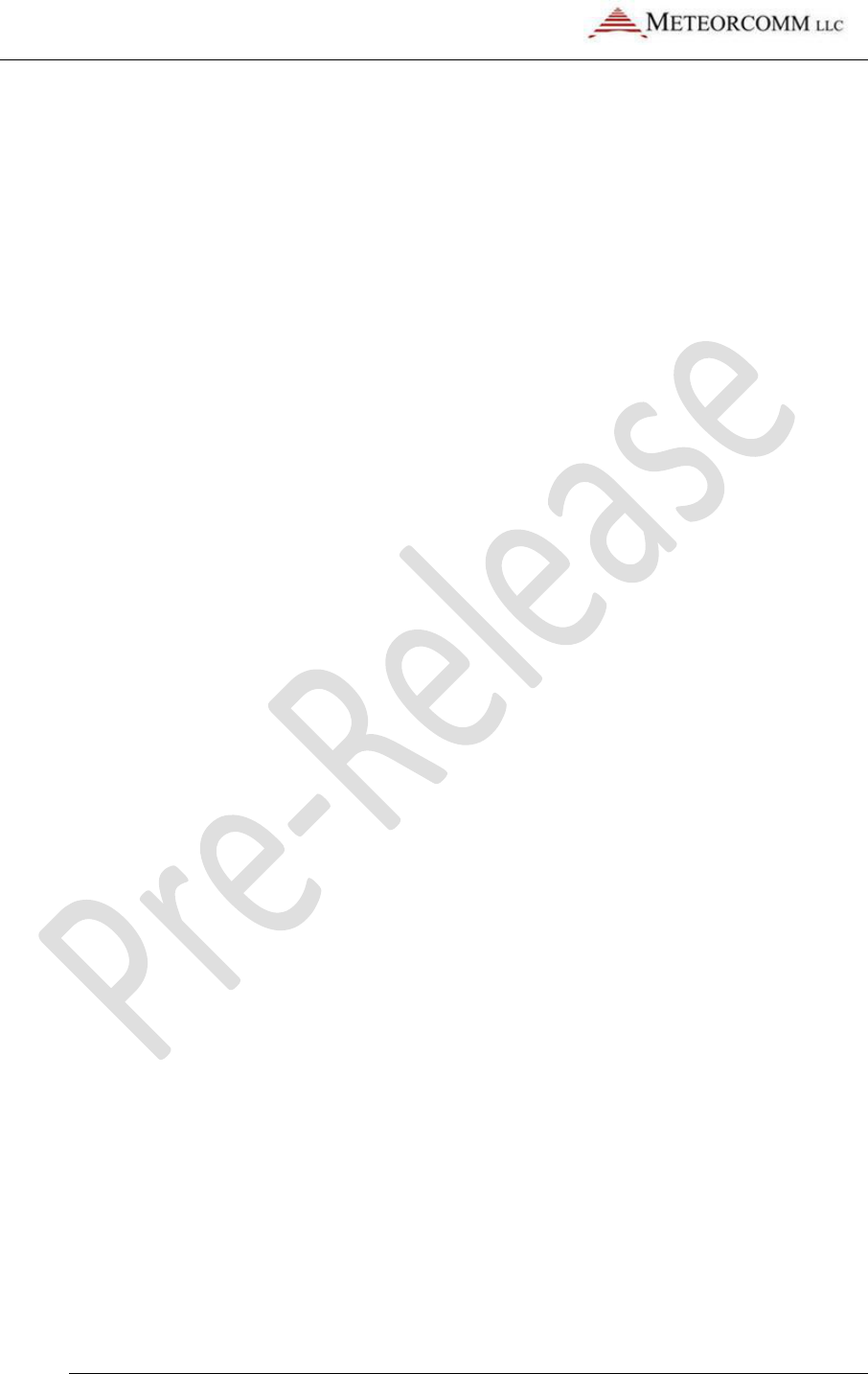
ITCR Base Radio User's Guide
© 2011 Meteorcomm LLC. All Rights Reserved. Proprietary and Confidential
2 Do Not Distribute 9/8/2011
1.3 Chassis
Base radios are housed in electrically sealed metal cases. The Base radio fits within a
standard 19” rack mount and has a maximum depth of 24 inches and a height rack
of 4 RUs, weighing less than 25 lbs.
It contains a fan with a temperature sensor that can be set to turn on at a
configurable temperature.
All input/output ports are grounded and/or shielded. In addition, best engineering
practices have been employed with respect to internal shielding, unit assembly and
PCB design in an effort to minimize potential sources of unwanted radiated
emissions.
1.4 Ports and Ethernet Connectors
The Base radio supports two RJ45 Ethernet I/O ports, each on its own network.
1.5 Power Connectors
The Base radio has two studs (marked ‘+’ and ‘-‘) to support the connection of power
cables. See input power requirements further below.
1.6 Antenna Connectors
The Base radio supports N-type connectors for narrowband RF antenna(s). The
connector marked TX/RX should be routed to the transmit antenna. The connectors
marked RX1 and RX2 are provided for optional use of separate receiving antennas.

ITCR Base Radio User's Guide
© 2011 Meteorcomm LLC. All Rights Reserved. Proprietary and Confidential
9/8/2011 Do Not Distribute 3
2. Important Information for the User
2.1 Transmitter Warm-up Period.
The base transmitter uses a precision oven-controlled crystal oscillator (OCXO). The
OCXO warm-up period is one minute minimum after application of input power
before any transmission should commence.
2.2 RF Safety
This radio is intended for use in occupational/controlled conditions, where users
have full knowledge of their exposure and can exercise control over their exposure
to meet FCC and IC limits. This radio device is NOT authorized for general
population, consumer, or any other use.
This two-way radio uses electromagnetic energy in the radio frequency (RF)
spectrum to provide communications between two or more users over a distance. It
uses RF energy or radio waves to send and receive calls. RF energy is one form of
electromagnetic energy. Other forms include, but are not limited to, sunlight and x-
rays. RF energy, however, should not be confused with these other forms of
electromagnetic energy, which when used improperly, can cause biological damage.
Very high levels of x-rays, for example, can damage tissues and genetic material.
Experts in science, engineering, medicine, health, and industry work with
organizations to develop standards for safe exposure to RF energy. These standards
provide recommended levels of RF exposure for both workers and the general
public. These recommended RF exposure levels include substantial margins of
protection.
All 2-way radios marketed in North America are designed, manufactured, and tested
to ensure they meet government-established RF exposure levels. In addition,
manufacturers also recommend specific operating instructions to users of 2-way
radios. These instructions are important because they inform users about RF energy
exposure and provide simple procedures on how to control it. Please refer to the
following Web sites for more information on what RF energy exposure is and how to
control your exposure to assure compliance with established RF exposure limits.
http://www.fcc.gov/oet/rfsafety/rf-faqs.html
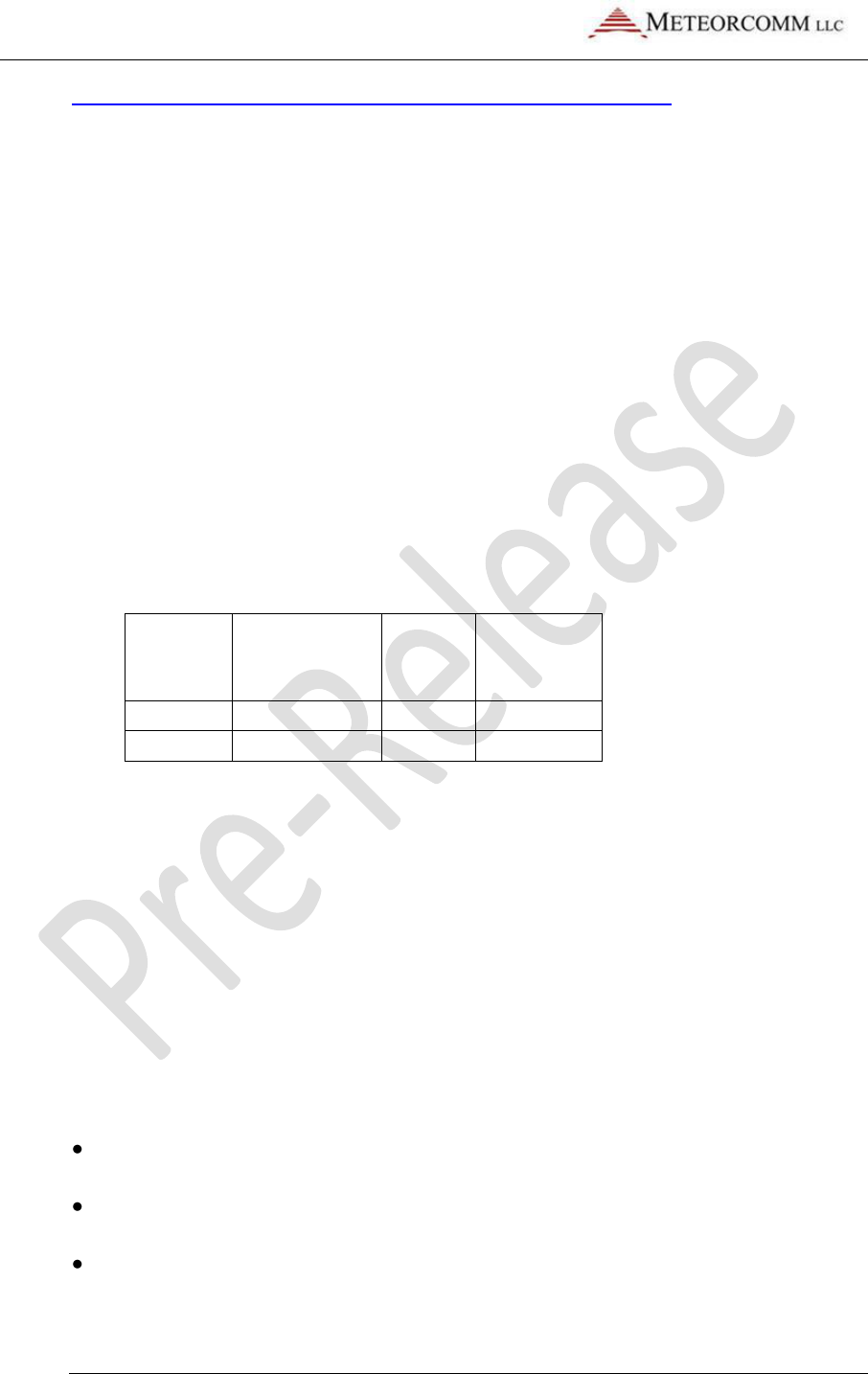
ITCR Base Radio User's Guide
© 2011 Meteorcomm LLC. All Rights Reserved. Proprietary and Confidential
4 Do Not Distribute 9/8/2011
http://www.osha.gov/SLTC/radiofrequencyradiation/index.html
2.3 Limiting RF Exposure
This transmitter is intended to be operated with a fixed antenna in an
Occupational/Controlled Exposure environment per FCC OET 65 or Controlled Use
Environment per IC RSS-102 and is not subject to specific absorption rate (SAR)
measurements. The Maximum Permitted Exposure (MPE) limit for this type device in
the 100-300 MHz range is 1mW/cm2 = 10W/m2.
The table below lists the calculated lateral distances to be maintained between
personnel and an operational base station transmitter antenna for two typical
antenna gains, 2.1 dBi for a vertical dipole or a vertical monopole over ground plane
and 8 dBi for a 2-element collinear vertical dipole antenna.
Table 1. Required Distance Between Personnel and Transmitting Antenna
Rated
Power, W
PEP
Maximum
Duty Cycle, %
Antenna
Gain,
dBi
Minimum
Lateral
Spacing, cm
75
50
2.1
70
75
50
8
137
Note: RF exposure compliance at multiple transmitter sites must be addressed on a
site-by-site basis. It is the responsibility of the licensee to ensure compliance with
maximum exposure limits.
2.4 Fixed Antenna Guidelines
This section contains antenna information and additional notes regarding methods
to limit RF exposure.
The licensee is required to comply with limits on power and effective antenna
height per 47CFR 90.729.
Install base station antennas on permanent outdoor structures that are not
intended for human occupation.
Acceptable antennas are vertical monopole over ground plane, vertical dipole,
multiple collinear vertical dipole, or similar designs.

ITCR Base Radio User's Guide
© 2011 Meteorcomm LLC. All Rights Reserved. Proprietary and Confidential
9/8/2011 Do Not Distribute 5
Unauthorized antennas, equipment modifications or attachments could
invalidate any equipment warranty or authority to transmit. Modification could
damage the radio and may violate FCC or IC regulations.
Install all antennas in accordance with the manufacturer’s instructions.
Maintain a safe distance from energized transmitting antennas. See above.
Disable the transmitter when installing or servicing its antenna or transmission
line.
2.5 RF Interference to Residential Receivers
NOTICE TO USER: This device complies with part 15 of the FCC Rules. Operation is
subject to the condition that this device does not cause harmful interference.
NOTE: This equipment has been tested and found to comply with the limits for a
Class B digital device, pursuant to Part 15 of the FCC Rules. These limits are
designed to provide reasonable protection against harmful interference in a
residential installation. This equipment generates, uses and can radiate radio
frequency energy and, if not installed and used in accordance with the instructions,
may cause harmful interference to radio communications. However, there is no
guarantee that interference will not occur in a particular installation. If this
equipment does cause harmful interference to radio or television reception, which
can be determined by turning the equipment off and on, the user is encouraged to
try to correct the interference by one or more the following measures:
Reorient or relocation the receiving antenna.
Increase the separation between the equipment and receiver.
Connect the equipment into an outlet on a circuit different from that to which
the receiver is connected.
Consult the dealer or an experienced radio/TV technician for help.
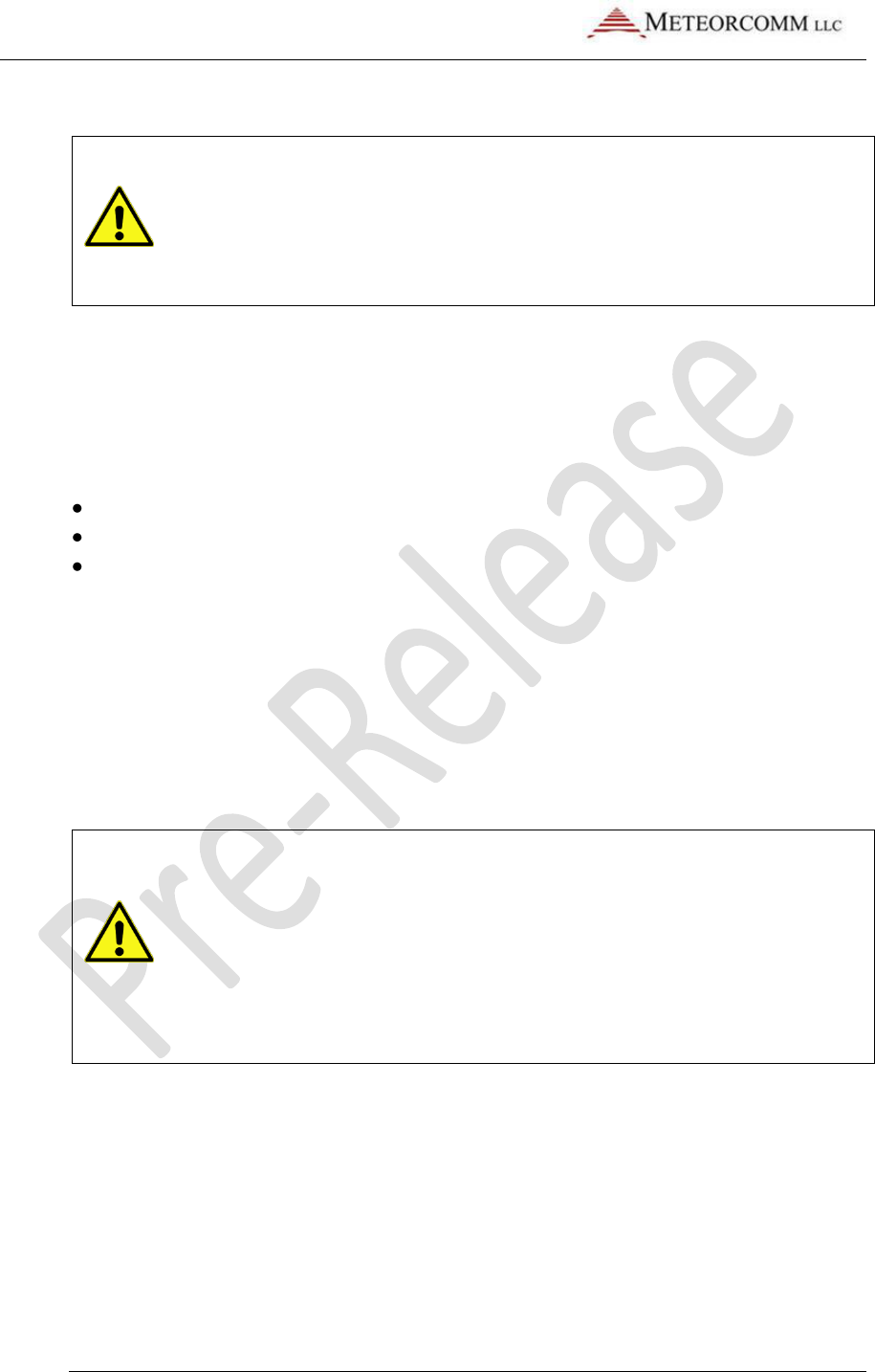
ITCR Base Radio User's Guide
© 2011 Meteorcomm LLC. All Rights Reserved. Proprietary and Confidential
6 Do Not Distribute 9/8/2011
2.6 Equipment Modifications
Caution: Any changes or modifications to this equipment not
expressly approved by the party responsible for compliance (in
the respective country of use) could void the user’s authority to
operate the equipment.
3. Setup and Configuration for the Base Radio
Set up physical connections with the following:
DC Power
Ethernet
RF output termination
The sections below identify each of the physical connections.
3.1 Input Power
A label on the radio chassis indicates the rated voltage of the base radio: 24 or 48V.
The table below describes the power supply requirements for each type.
Caution: Applying an incorrect voltage outside the rated voltage
range of a Base radio can damage it. Confirm the voltage ratings
of the radio and the power supply before applying power.
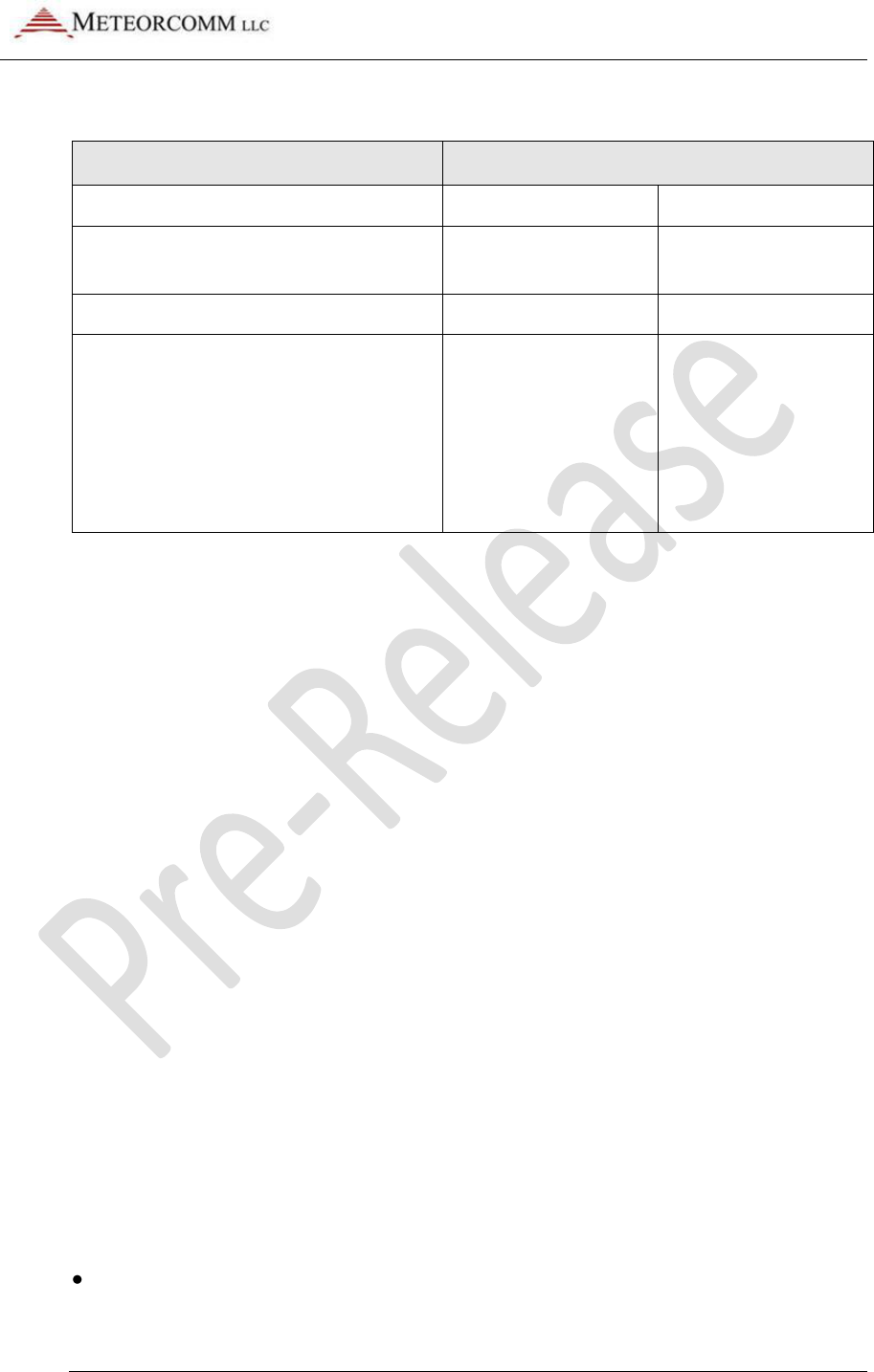
ITCR Base Radio User's Guide
© 2011 Meteorcomm LLC. All Rights Reserved. Proprietary and Confidential
9/8/2011 Do Not Distribute 7
Table 2. Base Radio Input Power Parameters
Parameter
Base Radio
Nominal DC Power Input Voltage
24VDC radio version
48VDC radio version
Operational Range
21-27 Vdc
(+/-12.5%)
42-54 Vdc
(+/-12.5%)
Damage limit
30VDC
60VDC
Current Drain (while transmitting
rated power)
11A peak max while
transmitting into 50
ohm load
7.5A for max
average operating
current
6A peak max while
transmitting into 50
ohm load
4A for max average
operating current
3.2 Ethernet Connection
Base radios use a standard CAT5 Ethernet cable connected between a PC and the
maintenance port of the radio. Configure the PC network card with a fixed IP
address of 10.10.1.254.
You will use XtermW, a Meteorcomm terminal emulation program, to connect with
and control the radio via commands issued at command prompts.
3.3 RF Output Termination
The Base radio is rated for 75W PEP max into a 50 ohm resistive load. Base radios
have a single TX/RX port with two additional ports for receiving only. For transmitter
testing, connect the test equipment to the port labeled “TX/RX.” A suitable RF power
attenuator should be used to protect test equipment.
4. Tuning the Base Radio
There are three parameters to test and potentially tune before/during RF testing:
Master reference crystal oscillator frequency
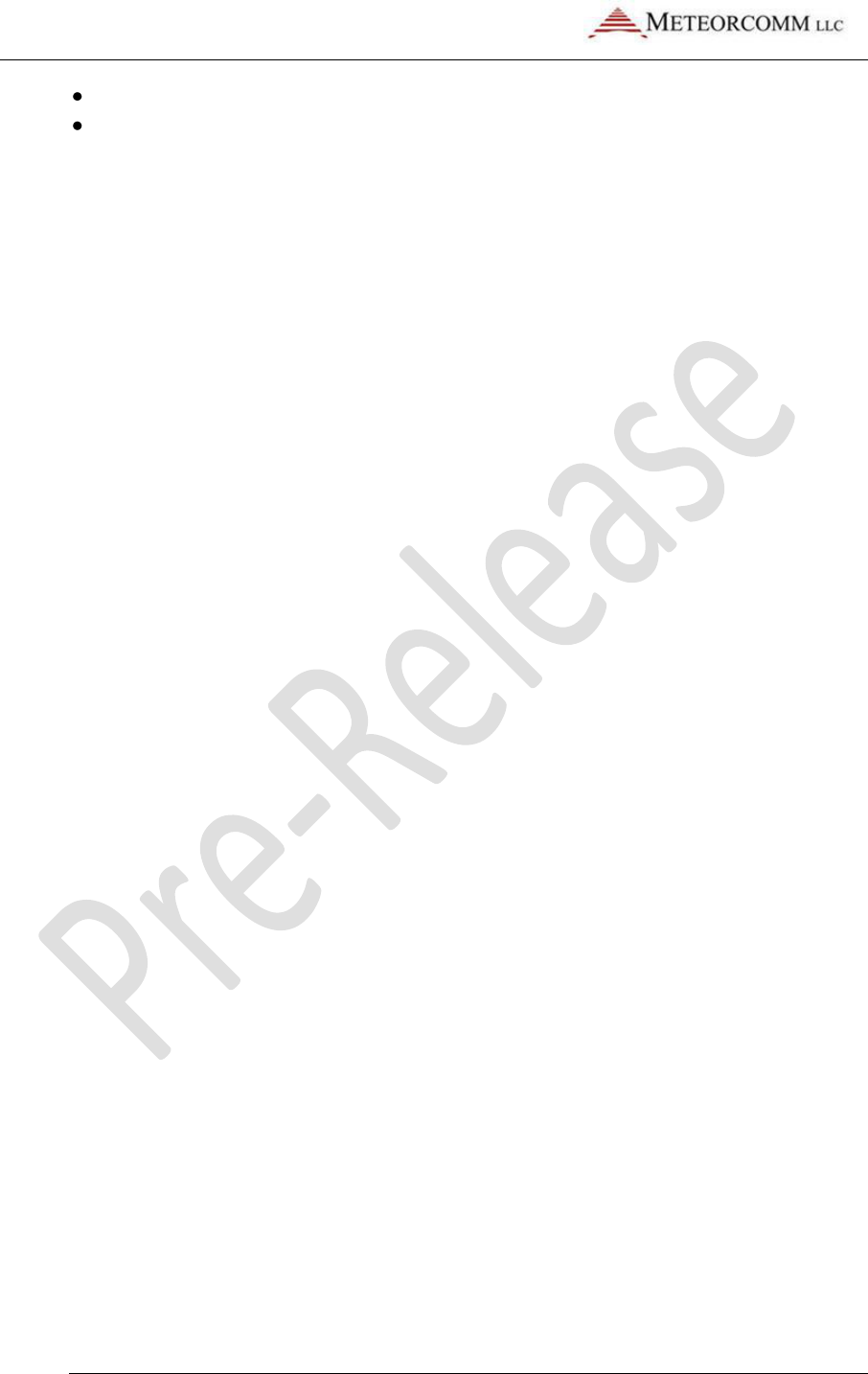
ITCR Base Radio User's Guide
© 2011 Meteorcomm LLC. All Rights Reserved. Proprietary and Confidential
8 Do Not Distribute 9/8/2011
RF output power
RF output channel
Factory technicians tune the master reference crystal oscillator and set the RF gain
for maximum rated output power. You may have to adjust the three parameters
before or during RF testing by entering commands using XtermW or any other
terminal emulation program.
4.1 Equipment Required
1. 10A DC power supply at rated voltage of base radio.
2. Personal computer with ethernet network adapter and Meteorcomm XtermW
or equivalent terminal program installed.
3. 30 dB 100W RF power attenuator.
4. Vector spectrum analyzer for power and frequency measurements.
5. Optional 8+ digit frequency counter for frequency measurements.
6. External high stability time base (e.g., rubidium) accurate to 0.01 ppm. Can be
internal to items 4 and 5.
4.2 Set up the Radio for Testing
1. Find the input voltage rating marking on the radio chassis. It is either 24VDC or
48VDC. Adjust a 10A DC power supply to the proper voltage; then disable its
output. Observing polarity markings connect the power supply between the
radio power terminals and the power supply.
2. Connect a CAT5 ethernet cable between the RJ-45 port labeled MAINT.
Connect the other end to a computer network card. The default radio IP
address is 10.10.1.254. Set the IP address of the computer network card to a
compatible fixed address such as 10.10.1.1. The computer should have
Meteorcomm XtermW or a similar terminal emulation program installed.
3. Apply power to the radio. Wait 30 seconds to open an XtermW session. Use
the Edit/Configure Port window to set Port Type = TCP/IP, Protocol = Stream,
TCP/IP Settings Host = 10.10.1.254, Port 4000. Select Device Type = MCC 6100
SDR (which also applies to ITC radios). Return Character = CR, Data Format =
ASCII.

ITCR Base Radio User's Guide
© 2011 Meteorcomm LLC. All Rights Reserved. Proprietary and Confidential
9/8/2011 Do Not Distribute 9
4. Attach a 100W 30 dB RF attenuator to the TX/RX N-type antenna connector.
Attach an (e.g., Agilent MXA or PXA) vector spectrum analyzer or similar to the
transmitter port for power and frequency measurements. The VSA should
contain either a precision stability reference oscillator or attach an external
rubidium reference to the VSA external reference input.
4.3 Measure and Calibrate Reference Crystal Oscillator
Parameters
The instructions below allow you to change the factory calibration settings for the
master reference oscillator crystal. The new setting is stored in volatile memory and
will revert to factory settings when the radio is powered off and then on.
To check the master reference crystal oscillator frequency calibration:
1. Open an XtermW session.
2. Put the radio into test mode by typing:
i. dsp,watchdog,off
ii. dsp_mode,test
3. Reduce output power to approximately 2W by typing:
i. cal,set,igain,-1000
ii. cal,set,qgain,-1000
4. Begin transmitting a test tone offset +8kHz from the carrier:
i. l1_test,stop
ii. l1_test,set,txmod,cw
iii. l1_test,set,txfreq,220012500
iv. l1_test,start,tx
5. Use the frequency counter or frequency counting marker on the VSA to measure
the output frequency. The measured value is exactly 8 kHz greater than the
actual carrier frequency. The carrier frequency is normally well within 22 Hz (0.1
ppm) of the carrier frequency.
6. Alternate to the test tone: Substitute the following π/4-DQPSK modulation
command for the second line in step 4.
i. l1_test,set,txmod,dqpsk
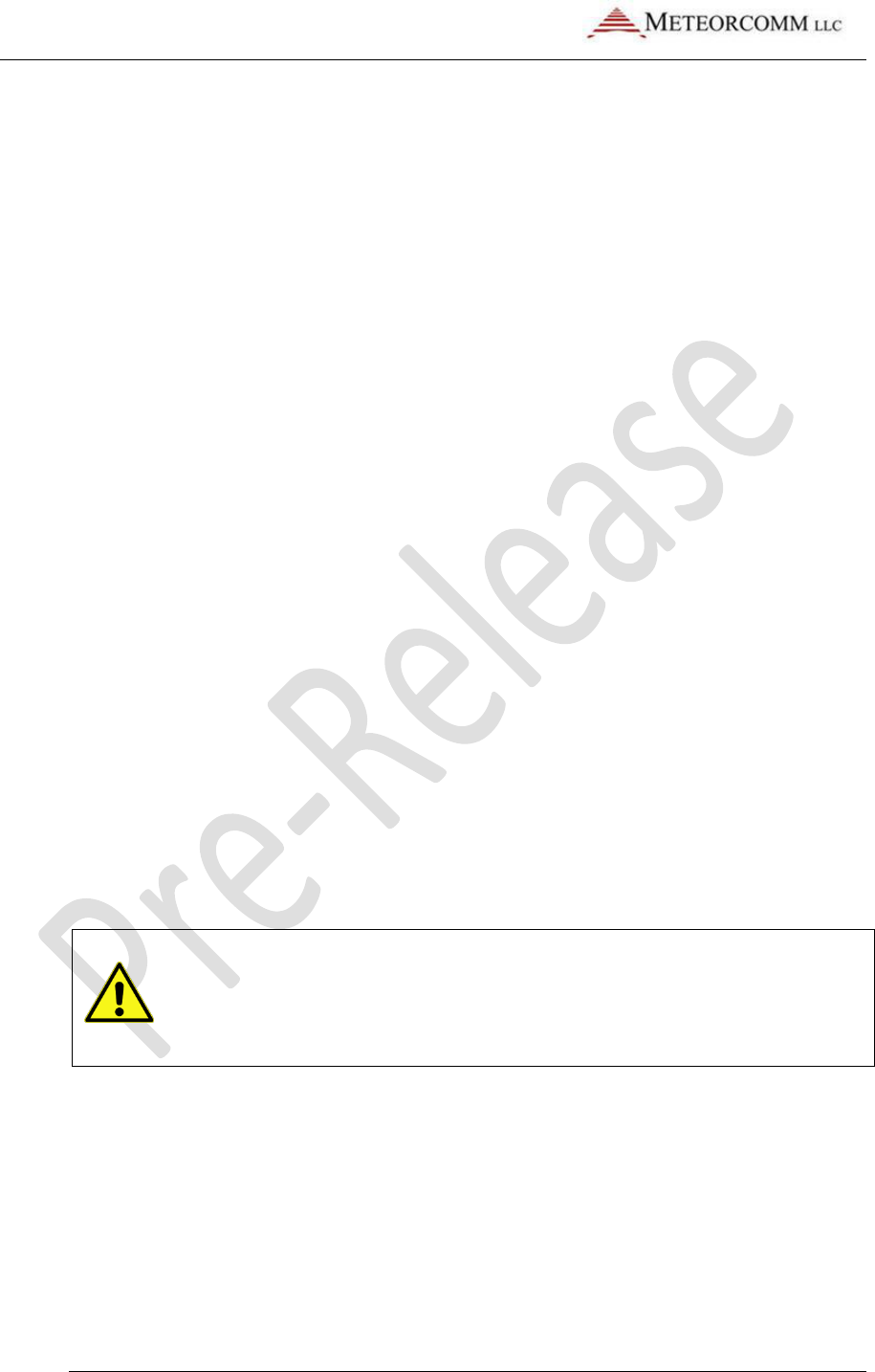
ITCR Base Radio User's Guide
© 2011 Meteorcomm LLC. All Rights Reserved. Proprietary and Confidential
10 Do Not Distribute 9/8/2011
7. Set the VSA to the center frequency of the channel and set it to demodulate the
16 ksym/second π/4-DQPSK emission and measure the error frequency which is
referenced to the VSA center frequency.
To adjust the master crystal reference oscillator parameters:
1. First, check the factory default setting for the crystal reference parameter by
typing
i. cal
2. Note the value for “xo” in the cal factors table that is displayed.
3. At the XtermW command line, type:
i. cal,set,xo,xx
ii. where xx is some value close to the original factory set value.
4. Use trial and error to determine the set point for the xo value to achieve the
desired carrier frequency accuracy.
To reset the XO tuning parameter to the factory setting:
Power cycle the radio.
4.4 Measure and Adjust Output Power
Caution: Avoid unnecessary adjustments. Exercise caution when setting I
and Q gain values as damage to the radio can occur if gains are set too
high.
Base radios are rated for 75W PEP. To achieve this power radios are pre-calibrated
at the factory. If additional tuning is required, use an appropriate method to
determine PEP for a π/4-DQPSK signal and slowly increase/decrease I and Q gain
levels from their nominal set point, as determined by issuing the command ‘cal’.
A step of 100 points (for example, -250 to -150) is approximately equivalent to an
increase of 2dB in power.

ITCR Base Radio User's Guide
© 2011 Meteorcomm LLC. All Rights Reserved. Proprietary and Confidential
9/8/2011 Do Not Distribute 11
To measure and adjust output power:
1. At the XtermW command line, begin transmitting a π/4-DQPSK signal by typing:
i. dsp,watchdog,off
ii. dsp_mode,test
iii. l1_test,stop
l1_test,set,txmod,dqpsk
l1_test,start,tx
2. View the calibration settings by typing:
i. cal
3. Note the values for igain and qgain. They are normally matched.
4. Increase the output level by entering larger matched values or reduce output
level using smaller matched values. Use cal command in between to verify the
new settings.
i. cal,set,igain,xxxx
ii. cal,set,qgain,xxxx
5. Tune the VSA to the center of the channel frequency and use the CCDF function
to measure the peak envelope power, average power and peak to average ratio.
4.5 Check and Adjust RF Output Channel
You can adjust the RF output channel by stopping transmission, setting transmission
frequency, and then starting transmission again.
To adjust RF output channel:
1. Tune the radio to the bottom channel (220.0125MHz) by typing:
l1_test,stop
l1_test,set,txfreq,220012500
l1_test,start,tx
2. Tune the radio to the mid-channel (221.0125MHz) by typing:
l1_test,stop,
l1_test,set,txfreq,221012500
l1_test,start,tx
3. Tune the radio to the high channel (221.9875MHz) by typing:
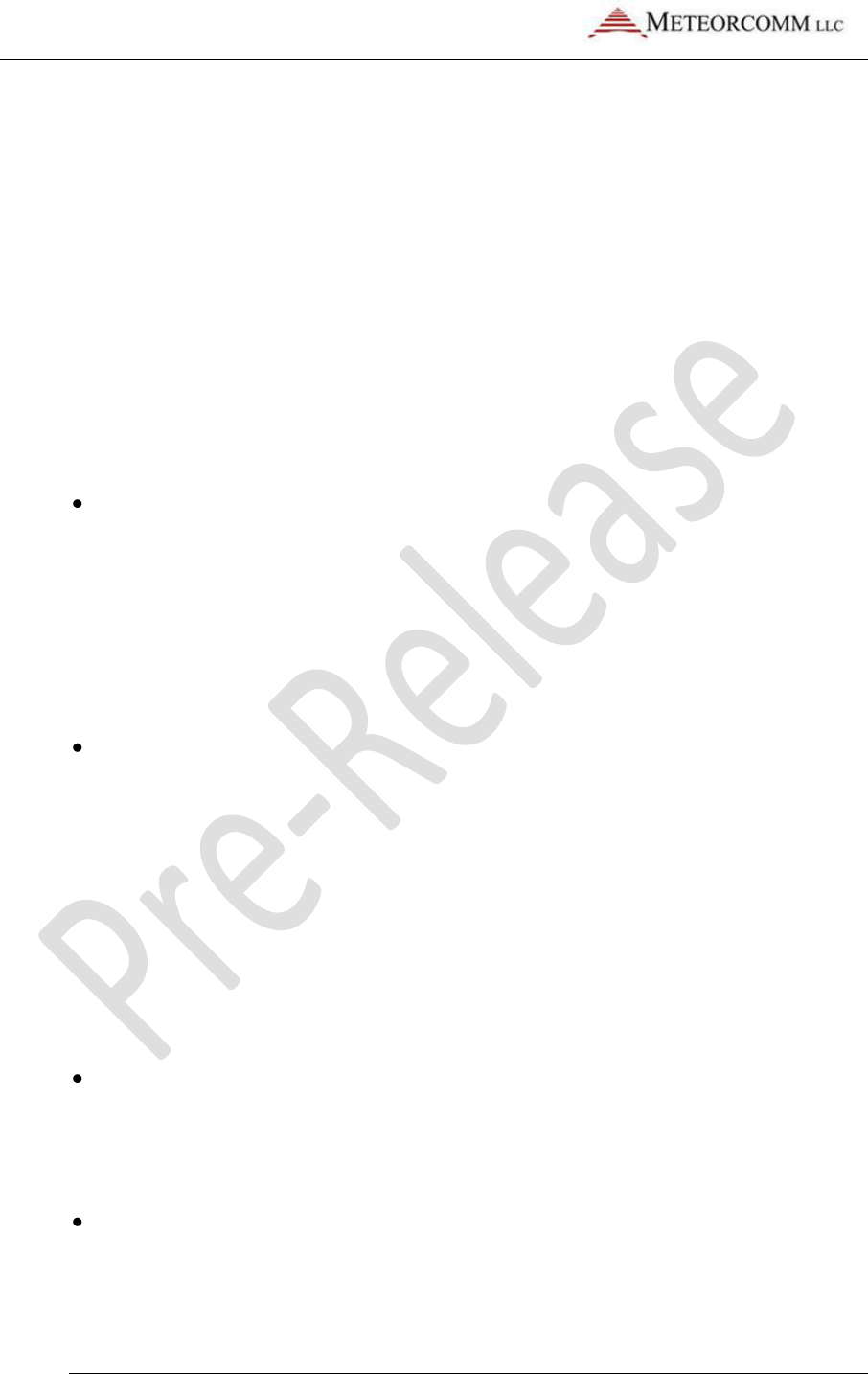
ITCR Base Radio User's Guide
© 2011 Meteorcomm LLC. All Rights Reserved. Proprietary and Confidential
12 Do Not Distribute 9/8/2011
l1_test,stop
l1_test,set,txfreq,221987500
l1_test,start,tx
5. Operations
This section provides commands used during normal operation of the Base radio.
5.1 Restore Factory Settings
To restore factory settings without cycling the radio:
At the XtermW command prompt, type:
factory
5.2 Display Software and Firmware Revision Numbers
To display what software and firmware versions are installed on your radio:
At the XtermW command prompt, type:
rev
5.3 Display Radio Identification Information
This section provides you with commands to display serial number and identification
information.
To display serial number information:
At the XtermW command prompt, type:
serialnumber
To show current ID setting:
At the XtermW command prompt, type:
ID